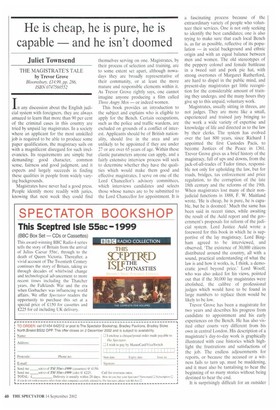He is cheap, he is pure, he is capable — and he isn't doomed
Juliet Townsend
THE MAGISTRATE'S TALE by Trevor Grove Bloomsbury, 114.99, pp. 286, ISBN 0747560552 In any discussion about the English judicial system with foreigners, they are always amazed to learn that more than 90 per cent of the criminal cases in this country are tried by unpaid lay magistrates. In a society where an applicant for the most unskilled job is required to be able to produce some paper qualification, the magistracy sails on with a magnificent disregard for such irrelevancies. Its requirements are simple but demanding: good character, common sense, fairness and good judgment, and it expects and largely succeeds in finding these qualities in people from widely varying backgrounds.
Magistrates have never had a good press. People identify more readily with juries, knowing that next week they could find themselves serving on one. Magistrates, by their process of selection and training, are to some extent set apart, although nowadays they are broadly representative of their community, or at least the more mature and responsible elements within it. As Trevor Grove rightly says, one cannot imagine anyone producing a film called Three Angry Men — or indeed women.
This book provides an introduction to the subject and explains who is eligible to apply for the Bench. Certain occupations, such as the police and traffic wardens, are excluded on grounds of a conflict of interest. Applicants should be of British nationality, should live in the area and are unlikely to be appointed if they are under 27 or are over 65 years of age. Within these elastic parameters anyone can apply, and a fairly extensive interview process will seek to determine whether they have the qualities which would make them good and effective magistrates. I serve on one of the Lord Chancellor's advisory committees, which interviews candidates and selects those whose names are to be submitted to the Lord Chancellor for appointment. It is a fascinating process because of the extraordinary variety of people who volunteer their services. One is not only seeking to identify the best candidates; one is also trying to make sure that each local Bench is, as far as possible, reflective of its population — in social background and ethnic origin and with an equal balance between men and women. The old stereotypes of the peppery colonel and female battleaxe in a tweed suit and pork pie hat, with strong overtones of Margaret Rutherford, are hard to dispel in the public mind, and present-day magistrates get little recognition for the considerable amount of training they undergo, and the many hours they give up to this unpaid, voluntary work.
Magistrates, usually sitting in threes, are not judges. They are more like a small, experienced and trained jury bringing to the work a wide variety of expertise and knowledge of life and directed as to the law by their clerks. The system has evolved over the last 800 years, since Richard I appointed the first Custodes Pacis, to become Justices of the Peace in 1361. Trevor Grove gives us a brief history of the magistracy, full of ups and downs, from the jack-of-all-trades of Tudor times, responsible not only for upholding the law, but for roads, bridges, tax enforcement and price regulation, to the corruption of the late 18th century and the reforms of the 19th. When magistrates lost many of their nonjudicial functions in 1888, F. W. Maitland wrote, 'He is cheap, he is pure, he is capable, but he is doomed.' Much the same has been said in recent times, while awaiting the result of the Auld report and the government's proposals for reform of the judicial system. Lord Justice Auld wrote a foreword for this book in which he is supportive of the lay magistracy. Lord Bingham agreed to be interviewed, and observed, 'The existence of 30,000 citizens distributed around the country, all with a sound, practical understanding of what the law is and how it works, is, I think, a democratic jewel beyond price.' Lord Woolf, who was also asked for his views, pointed out that if the 30,000 lay magistrates were abolished, the calibre of professional judges which would have to be found in large numbers to replace them would be likely to be low.
Trevor Grove has been a magistrate for two years and describes his progress from candidate to appointment and his early experiences on the Bench. He has also visited other courts very different from his own in central London. His description of a magistrate's day-to-day work is graphically illustrated with case histories which highlight the frustrations and satisfactions of the job. The endless adjournments for reports, or because the accused or a witness fails to turn up, must be maddening, and it must also be tantalising to hear the beginning of so many stories without being destined to hear the end.
It is surprisingly difficult for an outsider to find out exactly what the work of a magistrate involves. Anyone thinking of putting themselves forward would do well to read this book. It is readable and informative and gives a clear picture of the modern-day successors to the magistrates of the past in fact and fiction, from Francis Drake to Justice Shallow, from Oliver Cromwell to Henry Fielding, from Charles Darwin to Lord Emsworth — a mixed bag, but not without interest.











































































 Previous page
Previous page